It's not your imagination. Weather and climate disasters have been getting more frequent since the '70s

A chairlift at Sierra-at Tahoe ski resort sits idle as the Caldor Fire moves through the area on August 30, 2021 in Twin Bridges, California.
(CNN)An extreme weather event or climate disaster has occurred every day, on average, somewhere in the world over the last 50 years, marking a five-fold increase over that period, a new UN analysis shows.
Each extreme weather and climate-related disaster carried an average economic loss of a staggering $383 million, according to the report by the World Meteorological Organization. The economic toll of these disasters has climbed seven-fold since the 1970s.
The report examined more than 11,000 weather-related disasters over the past five decades and comes at the tail end of a summer packed with extreme weather across the Northern Hemisphere: While the United States has been battered by a cocktail of drought-fueled wildfires, floods and, more recently, Hurricane Ida, China and Germany experienced deadly flooding events in July as southern Europe battled wildfires of its own.
"What we think of as climate change is now becoming very personal," Jennifer Marlon, a climate scientist at the Yale School of the Environment, told CNN. "It's not far away anymore it's now in our front yard, it's in our backyards, it's in our basements, it's even in our lungs as breathing smoke from these wildfires."

Cyclone Idai hit the Mozambican coast in April 2019, devastating the port city of Beira and killing hundreds of people in Mozambique, Zimbabwe and Malawi.
But the good news is that these disasters are killing far fewer people, thanks to lessons learned from past disasters, and improved early warning and management systems. In the 1970s and 1980s, climate change-fueled disasters killed an average of roughly 170 people each day globally. That number dwindled to about 40 a day in the 2010s.
"The economic cost of Hurricane Ida is still to be fully assessed, as the true extent of the damage becomes apparent," WMO's secretary-general Petteri Taalas told CNN. "But it is clear that the loss of life was kept to a minimum because of all the lessons learned from Hurricane Katrina and the excellent early warning systems."
In Europe, although storms and flooding were the most prevalent drivers of disasters there, extreme heat accounted for the highest number of deaths — 93% — with nearly 150,000 lives lost over the last 50 years. In Africa, droughts caused the highest number of deaths, accounting for 95% of weather-related deaths in the region.

Dozens of people died during a flooding event that destroyed the barrio of San Bernardino in Caracas, Venezuela, in December 1999.
While extreme weather events can impact anyone in the world, the report found they strike and impact different countries and groups of people unequally. More than 91% of weather and climate disaster-related deaths occurred in developing countries, for example.
"By contrast, the loss of life from Tropical Cyclone Idai, which hit Mozambique in 2019, was very high because the forecasts did not give enough indication about the impact of the winds, rain and flooding, and did not reach those who needed them most," Taalas added. Cyclone Idai killed more than 1,000 people in Mozambique, Zimbabwe and Malawai in 2019.
The financial costs and lost incomes associated with these extreme weather events are also mounting dramatically, accounting for three-quarters of all reported economic losses.
"It's encouraging, certainly, that the number of deaths are going down, but the economics are deeply disturbing," said Marlon, who was not involved with the report.
According to the report, storms and floods caused the largest economic losses.
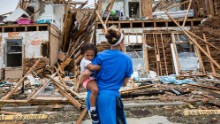
Photos: Hurricane Harvey slams Texas
Rockport residents return to their destroyed home.
Hide Caption
12 of 22
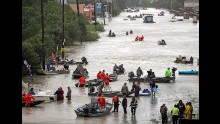
Photos: Hurricane Harvey slams Texas
Rescue boats fill Tidwell Road in Houston as they help flood victims evacuate the area.
Hide Caption
13 of 22
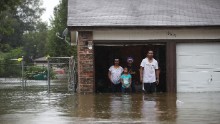
Photos: Hurricane Harvey slams Texas
People wait to be rescued from their flooded home in Houston.
Hide Caption
14 of 22
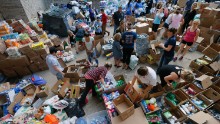
Photos: Hurricane Harvey slams Texas
Volunteers in Dallas organize items donated for hurricane victims.
Hide Caption
15 of 22
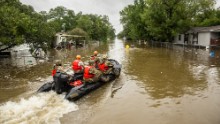
Photos: Hurricane Harvey slams Texas
When Harvey slammed the Texas coast and flooded much of Houston, volunteers sprang into action. Some came from as far away as the Florida Everglades, boats in tow, ready to rescue people trapped in their homes.
Hide Caption
16 of 22

Photos: Hurricane Harvey slams Texas
Larry Koser Jr. and his son Matthew look for important papers and heirlooms inside a flooded home in Houston.
Hide Caption
17 of 22

Photos: Hurricane Harvey slams Texas
Members of the National Guard rest at a furniture store in Richmond, Texas.
Hide Caption
18 of 22
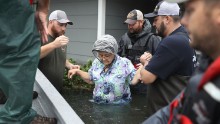
Photos: Hurricane Harvey slams Texas
Volunteer rescue workers help a woman from her flooded home in Port Arthur, Texas.
Hide Caption
19 of 22
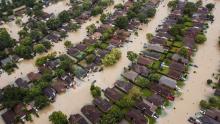
Photos: Hurricane Harvey slams Texas
This aerial photo shows flooded residential neighborhoods in Houston.
Hide Caption
20 of 22
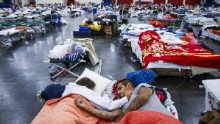
Photos: Hurricane Harvey slams Texas
Tammy Dominguez and her husband, Christopher, sleep on cots at the George R. Brown Convention Center, where thousands of people were taking shelter in Houston.
Hide Caption
21 of 22
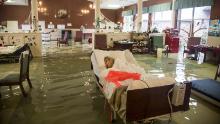
Photos: Hurricane Harvey slams Texas
An elderly patient waits to be rescued from the Gulf Health Care Center in Port Arthur. The facility was evacuated with the help of first responders and volunteers.
Hide Caption
22 of 22

Photos: Hurricane Harvey slams Texas
Downtown Houston is seen behind the flooded Buffalo Bayou a few days after Hurricane Harvey came ashore in August 2017. The Category 4 storm caused historic flooding. It set a record for the most rainfall from a tropical cyclone in the continental United States, with 51 inches of rain recorded in areas of Texas. An estimated 27 trillion gallons of water fell over Texas and Louisiana during a six-day period.
Hide Caption
1 of 22
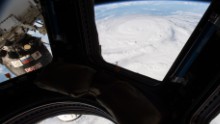
Photos: Hurricane Harvey slams Texas
NASA astronaut Jack Fischer photographed Hurricane Harvey from the International Space Station.
Hide Caption
2 of 22
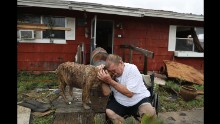
Photos: Hurricane Harvey slams Texas
Steve Culver comforts his dog Otis in the hurricane aftermath. Harvey destroyed most of his home in Rockport while he and his wife were there.
Hide Caption
3 of 22
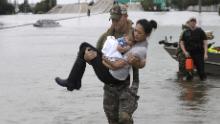
Photos: Hurricane Harvey slams Texas
Houston police officer Daryl Hudeck carries Catherine Pham and her 13-month-old son, Aiden, after rescuing them from floodwaters.
Hide Caption
4 of 22
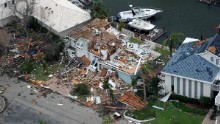
Photos: Hurricane Harvey slams Texas
A damaged home is seen in the Key Allegro neighborhood of Rockport.
Hide Caption
5 of 22

Photos: Hurricane Harvey slams Texas
A car is submerged by floodwaters on a freeway near downtown Houston.
Hide Caption
6 of 22

Photos: Hurricane Harvey slams Texas
Melani Zurawski cries while inspecting her home in Port Aransas, Texas.
Hide Caption
7 of 22
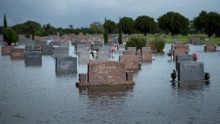
Photos: Hurricane Harvey slams Texas
A graveyard is flooded in Pearland, Texas.
Hide Caption
8 of 22
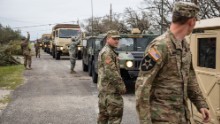
Photos: Hurricane Harvey slams Texas
Soldiers with the National Guard patrol Rockport, looking for residents trapped in their homes.
Hide Caption
9 of 22

Photos: Hurricane Harvey slams Texas
Evacuees are loaded onto a truck in Houston.
Hide Caption
10 of 22
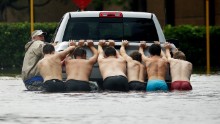
Photos: Hurricane Harvey slams Texas
People push a stalled pickup through a flooded street in Houston.
Hide Caption
11 of 22

Photos: Hurricane Harvey slams Texas
Rockport residents return to their destroyed home.
Hide Caption
12 of 22

Photos: Hurricane Harvey slams Texas
Rescue boats fill Tidwell Road in Houston as they help flood victims evacuate the area.
Hide Caption
13 of 22

Photos: Hurricane Harvey slams Texas
People wait to be rescued from their flooded home in Houston.
Hide Caption
14 of 22

Photos: Hurricane Harvey slams Texas
Volunteers in Dallas organize items donated for hurricane victims.
Hide Caption
15 of 22

Photos: Hurricane Harvey slams Texas
When Harvey slammed the Texas coast and flooded much of Houston, volunteers sprang into action. Some came from as far away as the Florida Everglades, boats in tow, ready to rescue people trapped in their homes.
Hide Caption
16 of 22

Photos: Hurricane Harvey slams Texas
Larry Koser Jr. and his son Matthew look for important papers and heirlooms inside a flooded home in Houston.
Hide Caption
17 of 22

Photos: Hurricane Harvey slams Texas
Members of the National Guard rest at a furniture store in Richmond, Texas.
Hide Caption
18 of 22

Photos: Hurricane Harvey slams Texas
Volunteer rescue workers help a woman from her flooded home in Port Arthur, Texas.
Hide Caption
19 of 22

Photos: Hurricane Harvey slams Texas
This aerial photo shows flooded residential neighborhoods in Houston.
Hide Caption
20 of 22

Photos: Hurricane Harvey slams Texas
Tammy Dominguez and her husband, Christopher, sleep on cots at the George R. Brown Convention Center, where thousands of people were taking shelter in Houston.
Hide Caption
21 of 22

Photos: Hurricane Harvey slams Texas
An elderly patient waits to be rescued from the Gulf Health Care Center in Port Arthur. The facility was evacuated with the help of first responders and volunteers.
Hide Caption
22 of 22

Photos: Hurricane Harvey slams Texas
Downtown Houston is seen behind the flooded Buffalo Bayou a few days after Hurricane Harvey came ashore in August 2017. The Category 4 storm caused historic flooding. It set a record for the most rainfall from a tropical cyclone in the continental United States, with 51 inches of rain recorded in areas of Texas. An estimated 27 trillion gallons of water fell over Texas and Louisiana during a six-day period.
Hide Caption
1 of 22

Photos: Hurricane Harvey slams Texas
NASA astronaut Jack Fischer photographed Hurricane Harvey from the International Space Station.
Hide Caption
2 of 22

Photos: Hurricane Harvey slams Texas
Steve Culver comforts his dog Otis in the hurricane aftermath. Harvey destroyed most of his home in Rockport while he and his wife were there.
Hide Caption
3 of 22

Photos: Hurricane Harvey slams Texas
Houston police officer Daryl Hudeck carries Catherine Pham and her 13-month-old son, Aiden, after rescuing them from floodwaters.
Hide Caption
4 of 22

Photos: Hurricane Harvey slams Texas
A damaged home is seen in the Key Allegro neighborhood of Rockport.
Hide Caption
5 of 22

Photos: Hurricane Harvey slams Texas
A car is submerged by floodwaters on a freeway near downtown Houston.
Hide Caption
6 of 22

Photos: Hurricane Harvey slams Texas
Melani Zurawski cries while inspecting her home in Port Aransas, Texas.
Hide Caption
7 of 22

Photos: Hurricane Harvey slams Texas
A graveyard is flooded in Pearland, Texas.
Hide Caption
8 of 22

Photos: Hurricane Harvey slams Texas
Soldiers with the National Guard patrol Rockport, looking for residents trapped in their homes.
Hide Caption
9 of 22

Photos: Hurricane Harvey slams Texas
Evacuees are loaded onto a truck in Houston.
Hide Caption
10 of 22

Photos: Hurricane Harvey slams Texas
People push a stalled pickup through a flooded street in Houston.
Hide Caption
11 of 22






















Six of the top most expensive weather and climate-related disasters around the world happened in the US alone, with three happening all in 2017: Hurricane Harvey in Texas caused $96.9 billion in losses; Hurricane Maria in Puerto Rico caused $69.4 billion; and Hurricane Irma, which hit Florida — along with the Caribbean — caused $58.2 billion. Hurricane Katrina, which hit the same area Ida just did, was responsible for the biggest loss.
The US Federal Emergency Management Agency (FEMA) has historically borrowed from the Treasury Department to pay claims for disasters. As of August 2020, FEMA's debt had ballooned to $20.5 billion, despite Congress erasing a $16 billion debt from Hurricane Katrina in October 2017 to pay for hurricanes Harvey, Irma and Maria.
Climate change has become a major driver to these disasters. According to peer-reviewed studies gathered by the Bulletin of the American Meteorological Society, roughly 80% of extreme weather events reported from 2015 to 2017 showed significant human influence. Nearly every analysis of major heatwaves since 2015 has been attributed in part to human-made climate change, the report said.
As the climate crisis accelerates, extreme weather events will become more frequent and severe. While the number of deaths are fewer than 50 years ago, Marlon said more people will still be at risk and more vulnerable to weather and climate-related disasters, unless the planet slashes greenhouse gas emissions and improves emergency preparedness systems.
"People need to recognize that these events that happened in the past are no longer a good predictor of the future and that we need to be much more prepared because we are in a different world," Marlon said. "We have more vulnerable people at risk, so we really need to develop a stronger culture of preparedness."
<a href="https://w02.jp/l/c/cJB6tZgp/OwioLESJ">《購入》【3500件の販売実績あり】倒産品/在庫処分/卸メール</a>
<a href="https://w02.jp/l/c/23W54ilU/OwioLESJ">《無料》【AFP】メール講座 物販の最高峰オールインワンツールX</a>
<a href="https://w02.jp/l/c/jc0ZFS9f/OwioLESJ">《無料》【中国仕入れ】メール講座 輸入代行サービス</a>
